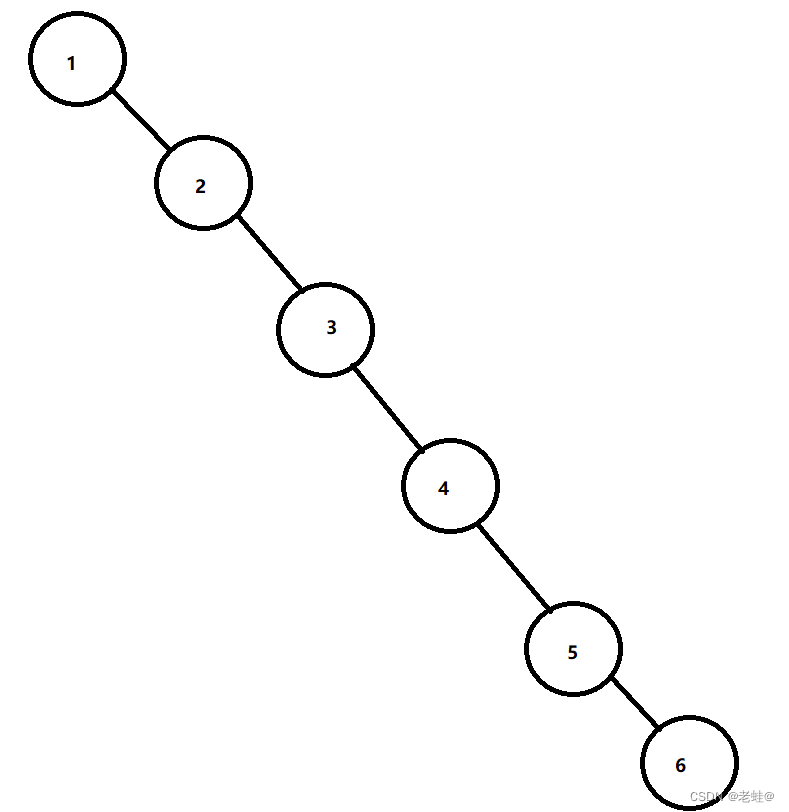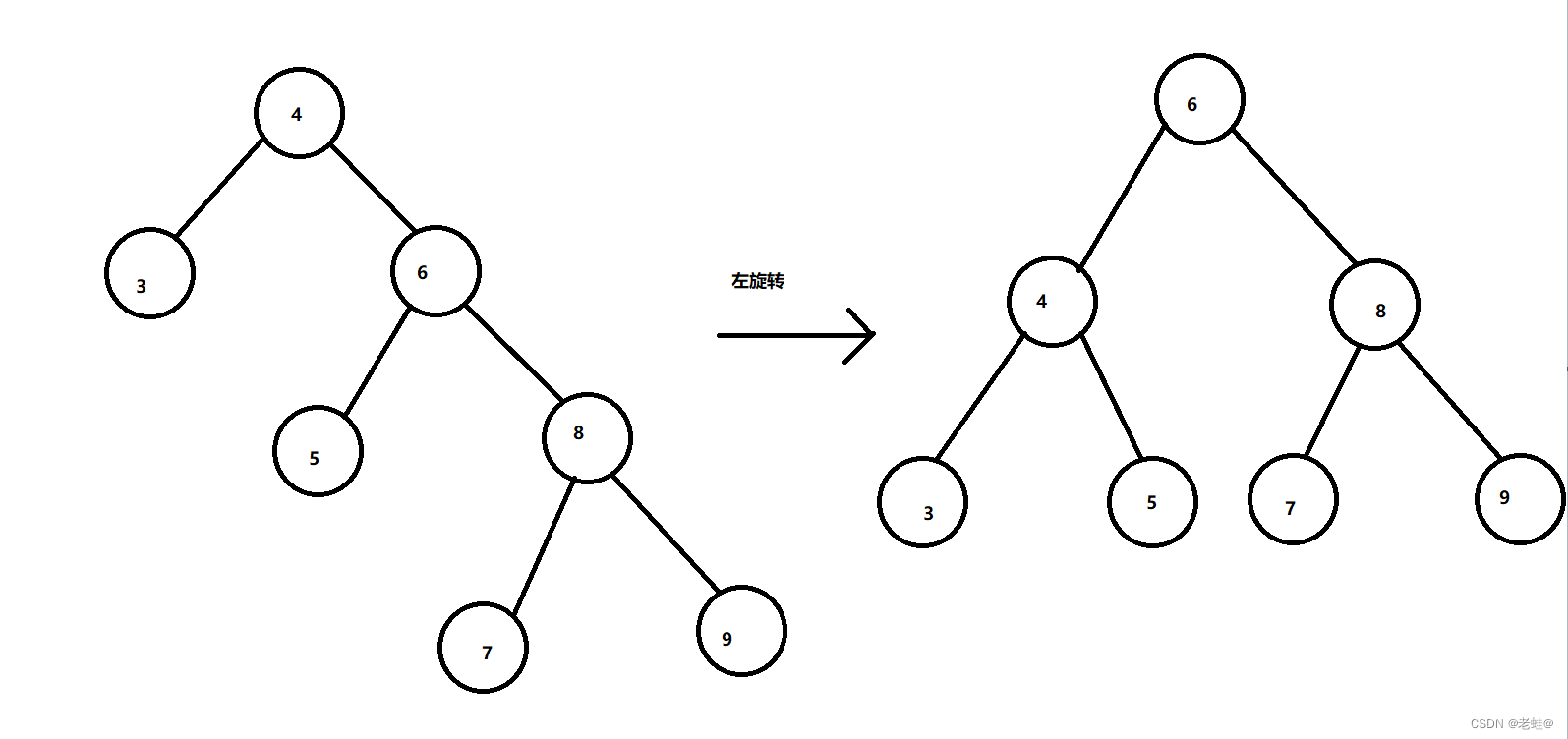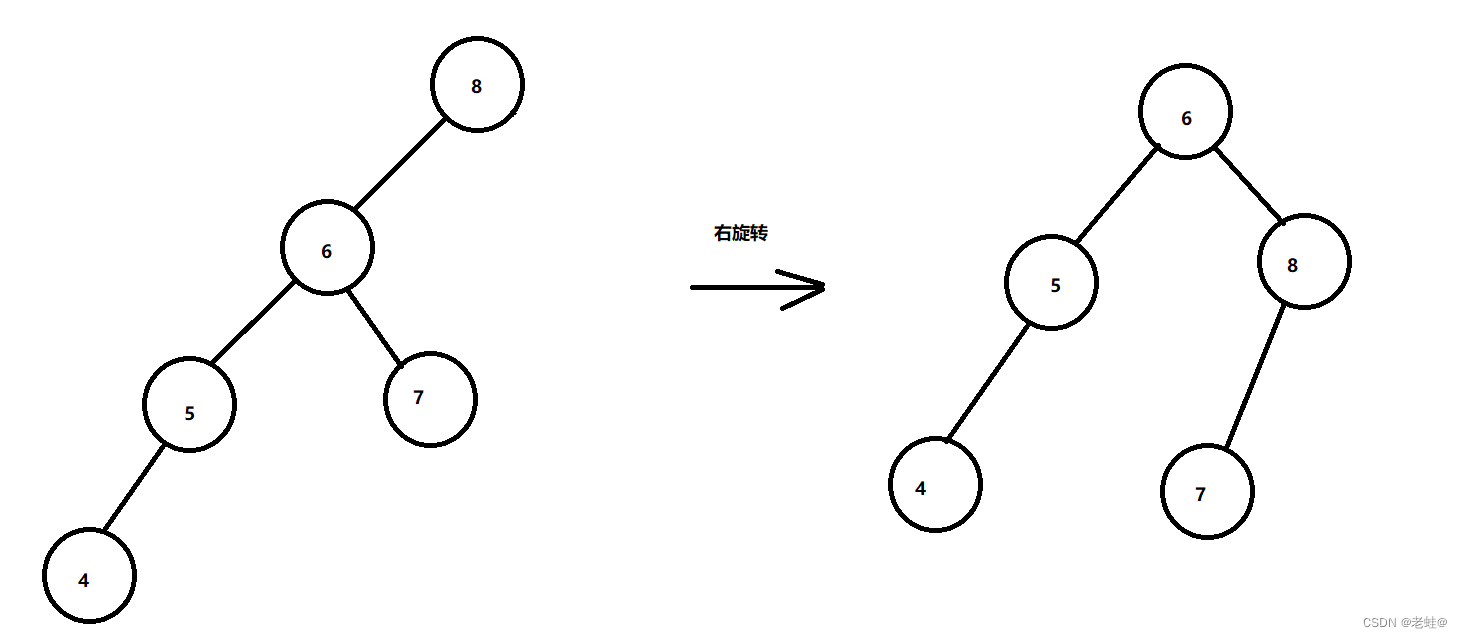二叉排序树(BST)
二叉排序树:BST(Binary Sort(Search) Tree),对于BST中任何一个非叶子结点,要求左子节点的值比当前结点的值小,右子节点的值比当前结点的值大。对于相同的值,可以将该结点放在左子节点或者右子节点
代码实现
- 添加结点:根据结点的值,将值小的结点放在左边,值大的结点放在右边
- 遍历结点:与一般树的前中后序遍历无异
- 删除结点:
- 删除叶子结点:找到需要删除的结点的父结点,然后将叶子结点置空
- 删除只有一个子结点的结点:找到需要删除的结点的父结点,将父结点的子结点位置改成子的子,即用子结点替换掉需要删除的节点
- 删除有两个子结点的结点:找到需要删除的结点的父结点,找到右子树的最左(小)结点、或左子树最右(大)结点替代需要删除的结点
/***
* 二叉排序树
*
* @author laowa
*
*/
class BinarySortTree {
Node root;
/**
* 添加结点
*
* @param node
*/
public void add(Node node) {
if (root == null) {
root = node;
return;
}
root.add(node);
}
/**
* 删除结点
*
* @param no
* 需要删除的结点的no
*/
public void delete(int no) {
// 判空
if (this.root == null) {
System.out.println("树为空");
return;
}
// 找到目标节点和目标节点的父结点
Node target = this.search(no);
// 如果没有找到目标结点直接退出方法
if (target == null) {
return;
}
Node parent = this.root.searchParent(no);
// 如果该树只有一颗结点,则直接根结点置空
if (root.left == null && root.right == null) {
this.root = null;
return;
}
if (target.left == null && target.right == null) {
// 如果左右子结点均为空,表示当前结点为叶子结点
// 找到目标结点在父结点的左边还是右边,然后置空
if (parent.left == target) {
parent.left = null;
} else {
parent.right = null;
}
return;
}
// 如果左子结点为空,说明只有一棵右子树
if (target.left == null) {
if (parent == null) {
// 如果父结点为空,即删除的结点是根结点
this.root = target.right;
} else {
// 找到目标结点在父结点的左边还是右边,然后指向目标结点的右边
if (parent.left == target) {
parent.left = target.right;
} else {
parent.right = target.right;
}
}
}
// 如果右子结点为空,说明只有一棵左子树
if (target.right == null) {
if (parent == null) {
// 如果父结点为空,即删除的结点是根节点
this.root = target.left;
} else {
// 找到目标结点在父结点的左边还是右边,然后指向目标结点的左边
if (parent.left == target) {
parent.left = target.left;
} else {
parent.right = target.left;
}
}
}
if (target.left != null && target.right != null) {
// 如果目标结点的左右子结点均不为空
Node temp = target.right;
// 向左循环查找一直找到最左边的结点,此时temp保存了这个结点
while (temp.left != null) {
temp = temp.left;
}
// 删除该结点
delete(temp.no);
// 将目标结点的左右子结点赋值给该结点
temp.left = target.left;
temp.right = target.right;
// 如果parent为空表示删除的结点是根节点,没有父结点,否则找到目标结点在父结点的左边还是右边,并且设置为temp结点
if (parent != null) {
if (parent.left == target) {
parent.left = temp;
} else {
parent.right = temp;
}
} else {
this.root = temp;
}
}
}
/**
* 查找目标结点
*
* @param no
* 目标结点的编号
* @return 结点
*/
public Node search(int no) {
if (this.root == null) {
return null;
}
return this.root.search(no);
}
/**
* 中序遍历
*/
public void infixOrder() {
if (root == null) {
System.out.println("树为空");
return;
}
root.infixOrder();
}
}
/***
* 二叉排序树结点
*
* @author laowa
*
*/
class Node {
int no;
Node left;
Node right;
public Node(int no) {
this.no = no;
}
@Override
public String toString() {
return "[Node value=" + no + "]";
}
/**
* 查找当前需要删除的结点
*
* @param no
* 结点编号
*/
public Node search(int no) {
if (this.no == no) {
// 如果当前结点为需要查找的结点,返回
return this;
}
if (this.no > no) {
// 如果目标编号小于当前结点,表示目标结点在左边
if (this.left != null) {
return this.left.search(no);
}
// 没找到
return null;
}
// 如果目标编号大于当前结点,表示目标结点在右边
if (this.right != null) {
return this.right.search(no);
}
// 没找到
return null;
}
/**
* 查找需要删除的结点的父结点
*
* @param no
* @return
*/
public Node searchParent(int no) {
// 如果作右子结点中存在目标结点,则放回当前结点
if ((this.left != null && this.left.no == no) || (this.right != null && this.right.no == no)) {
return this;
}
// 如果当前结点大于目标结点,向左递归查找
if (this.no > no && this.left != null) {
return this.left.searchParent(no);
}
// 如果当前结点小于目标结点,向右递归查找
if (this.no < no && this.right != null) {
return this.right.searchParent(no);
}
// 没找到返回null
return null;
}
/**
* 添加结点
*
* @param node
* 待添加的结点
*/
public void add(Node node) {
// 判空,添加的结点为空则不添加
if (node == null) {
return;
}
if (node.no < this.no) {
// 如果待添加的结点小于当前节点,想左子树添加
if (this.left == null) {
// 如果左子节点为空则直接加载左边
this.left = node;
} else {
// 否则向左子结点递归添加
this.left.add(node);
}
} else {
// 如果待添加的结点大于或等于当前结点,向右子树添加
if (this.right == null) {
// 如果右子节点为空则直接加在右边
this.right = node;
} else {
// 否则向右子结点递归添加
this.right.add(node);
}
}
}
/**
* 中序遍历
*/
public void infixOrder() {
if (this.left != null) {
this.left.infixOrder();
}
System.out.println(this);
if (this.right != null) {
this.right.infixOrder();
}
}
}
平衡二叉树(AVL)
问题导入
使用数列{1,2,3,4,5,6}创建一棵二叉排序树,将会得到这样一棵树:

这棵二叉排序树存在这些问题:
- 左子树全部为空,从形式上看,更像一个单链表,失去了树结构的意义
- 插入速度没有影响
- 查询速度明显降低,不能发挥BST的优势
基本介绍
- 平衡二叉树也叫平衡二叉搜索树,又称为AVL树,它可以保证较高的查询效率
- 它具有以下特点:它是一颗空树或它的左右两个子树的高度查的绝对值不超过1,并且左右两棵子树都是一颗平衡二叉树,平衡二叉树的常用实现有:红黑树、AVL、替罪羊树、Treap、伸展树等
代码实现
-
当右边子树高度高于左边子树高度+1时,进行左旋转

-
当左边子树高度高于右边子树高度+1时,进行右旋转

-
当右边子树高度高于左边子树高度+1,并且右子树的左子树高于右边子树+1,左旋转后右子树高的一部分被转到了左子树,这样仍然不平衡,此时需要双旋转,即先将右子节点进行右旋转,让右子树平衡,再让当前结点进行左旋转,对于左子树亦然
/**
* AVL树
*
* @author laowa
*
*/
class AvlTree {
Node root;
/**
* 添加结点
*
* @param node
*/
public void add(Node node) {
if (root == null) {
root = node;
return;
}
root.add(node);
}
/**
* 获取树的高度
* @return 树的高度
*/
public int height() {
return this.root.height();
}
/**
* 删除结点
*
* @param no
* 需要删除的结点的no
*/
public void delete(int no) {
// 判空
if (this.root == null) {
System.out.println("树为空");
return;
}
// 找到目标节点和目标节点的父结点
Node target = this.search(no);
// 如果没有找到目标结点直接退出方法
if (target == null) {
return;
}
Node parent = this.root.searchParent(no);
// 如果该树只有一颗结点,则直接根结点置空
if (root.left == null && root.right == null) {
this.root = null;
return;
}
if (target.left == null && target.right == null) {
// 如果左右子结点均为空,表示当前结点为叶子结点
// 找到目标结点在父结点的左边还是右边,然后置空
if (parent.left == target) {
parent.left = null;
} else {
parent.right = null;
}
return;
}
// 如果左子结点为空,说明只有一棵右子树
if (target.left == null) {
if (parent == null) {
// 如果父结点为空,即删除的结点是根结点
this.root = target.right;
} else {
// 找到目标结点在父结点的左边还是右边,然后指向目标结点的右边
if (parent.left == target) {
parent.left = target.right;
} else {
parent.right = target.right;
}
}
}
// 如果右子结点为空,说明只有一棵左子树
if (target.right == null) {
if (parent == null) {
// 如果父结点为空,即删除的结点是根节点
this.root = target.left;
} else {
// 找到目标结点在父结点的左边还是右边,然后指向目标结点的左边
if (parent.left == target) {
parent.left = target.left;
} else {
parent.right = target.left;
}
}
}
if (target.left != null && target.right != null) {
// 如果目标结点的左右子结点均不为空
Node temp = target.right;
// 向左循环查找一直找到最左边的结点,此时temp保存了这个结点
while (temp.left != null) {
temp = temp.left;
}
// 删除该结点
delete(temp.no);
// 将目标结点的左右子结点赋值给该结点
temp.left = target.left;
temp.right = target.right;
// 如果parent为空表示删除的结点是根节点,没有父结点,否则找到目标结点在父结点的左边还是右边,并且设置为temp结点
if (parent != null) {
if (parent.left == target) {
parent.left = temp;
} else {
parent.right = temp;
}
} else {
this.root = temp;
}
}
}
/**
* 查找目标结点
*
* @param no
* 目标结点的编号
* @return 结点
*/
public Node search(int no) {
if (this.root == null) {
return null;
}
return this.root.search(no);
}
/**
* 中序遍历
*/
public void infixOrder() {
if (root == null) {
System.out.println("树为空");
return;
}
root.infixOrder();
}
}
/***
* AVL树结点
*
* @author laowa
*
*/
class Node {
int no;
Node left;
Node right;
public Node(int no) {
this.no = no;
}
@Override
public String toString() {
return "[Node value=" + no + "]";
}
/**
* 获取以当前结点为根节点的树的高度
*
* @return 一个整数,为以当前结点为根节点的树的高度
*/
public int height() {
// 递归向左右获取高度,去左右高度的最大值,每次获取到会加一,即每一层高度加一
return Math.max(this.left == null ? 0 : this.left.height(), this.right == null ? 0 : this.right.height()) + 1;
}
/**
* 获取左子树的高度
*
* @return 一个整数,左子树的高度
*/
public int leftHeight() {
return this.left == null ? 0 : this.left.height();
}
/**
* 获取右子树的高度
*
* @return 一个整数,右子树的高度
*/
public int rightHeight() {
return this.right == null ? 0 : this.right.height();
}
/**
* 左旋转
*/
private void leftRotate() {
//以当前结点的值创建一个新的结点,这个新节点后面会被作为左子节点
Node newNode = new Node(this.no);
//新结点的左子节点为当前结点的左子节点
newNode.left = this.left;
//新节点的右子结点为当前结点的右子节点的左子节点
newNode.right = this.right.left;
//当前节点的值改为右子节点的值
this.no = this.right.no;
//右子节点指向右子结点的右子节点,丢弃右子节点
this.right = this.right.right;
//左子节点指向新节点,丢弃左子节点
this.left = newNode;
}
/**
* 右旋转
*/
private void rightRotate() {
//以当前结点的值创建一个新的结点,这个结点后面会被作为右子节点
Node newNode = new Node(this.no);
//新结点的左子节点指向当前结点的左子结点的右子节点
newNode.left = this.left.right;
//新结点的右子节点指向当前结点的右子节点
newNode.right = this.right;
//将当前节点的值改为左子节点的值,即左子节点上移
this.no = this.left.no;
//当前结点左子节点指向左子节点的左子节点,丢弃原来的左子节点
this.left = this.left.left;
//当前节点的右子节点指向新节点
this.right = newNode;
}
/**
* 查找结点
*
* @param no
* 结点编号
*/
public Node search(int no) {
if (this.no == no) {
// 如果当前结点为需要查找的结点,返回
return this;
}
if (this.no > no) {
// 如果目标编号小于当前结点,表示目标结点在左边
if (this.left != null) {
return this.left.search(no);
}
// 没找到
return null;
}
// 如果目标编号大于当前结点,表示目标结点在右边
if (this.right != null) {
return this.right.search(no);
}
// 没找到
return null;
}
/**
* 查找结点的父结点
*
* @param no
* @return
*/
public Node searchParent(int no) {
// 如果作右子结点中存在目标结点,则放回当前结点
if ((this.left != null && this.left.no == no) || (this.right != null && this.right.no == no)) {
return this;
}
// 如果当前结点大于目标结点,向左递归查找
if (this.no > no && this.left != null) {
return this.left.searchParent(no);
}
// 如果当前结点小于目标结点,向右递归查找
if (this.no < no && this.right != null) {
return this.right.searchParent(no);
}
// 没找到返回null
return null;
}
/**
* 添加结点
*
* @param node
* 待添加的结点
*/
public void add(Node node) {
// 判空,添加的结点为空则不添加
if (node == null) {
return;
}
if (node.no < this.no) {
// 如果待添加的结点小于当前节点,想左子树添加
if (this.left == null) {
// 如果左子节点为空则直接加载左边
this.left = node;
} else {
// 否则向左子结点递归添加
this.left.add(node);
}
} else {
// 如果待添加的结点大于或等于当前结点,向右子树添加
if (this.right == null) {
// 如果右子节点为空则直接加在右边
this.right = node;
} else {
// 否则向右子结点递归添加
this.right.add(node);
}
}
//当右子树的高度-左子树的高度之后大于1,进行左旋转
if(this.rightHeight()>this.leftHeight()) {
//如果右子节点的左子树高度-右节点的右子树高度>1,先让右子树平衡
if(this.right!=null&&this.right.leftHeight()>this.right.rightHeight()) {
this.right.rightRotate();
}
this.leftRotate();
//当左子树的高度-右子树的高度之后大于1,进行右旋转
}else if(this.leftHeight()>this.rightHeight()) {
//如果左子节点的右子树高度-左节点的左子树高度>1,先让左子树平衡
if(this.left!=null&&this.left.rightHeight()>this.left.leftHeight()) {
this.left.leftRotate();
}
this.rightRotate();
}
}
/**
* 中序遍历
*/
public void infixOrder() {
if (this.left != null) {
this.left.infixOrder();
}
System.out.println(this);
if (this.right != null) {
this.right.infixOrder();
}
}
}
多叉树
二叉树的问题分析
二叉树需要加载到内存,如果二叉树的结点少,没有什么问题,但如果二叉树的结点非常多(比如上亿),就存在如下问题:
- 再构建二叉树时,需要进行多次操作(海量数据存在数据库或者文件中),结点海量,构建二叉树时的速度就慢
- 结点海量也会操作二叉树的高度很大,降低其他的操作速度
多叉树
- 在二叉树中每个结点有数据项,最多两个子结点,如果允许每个结点可以有更多的数据项和更多的子结点,就是多叉树
- 如2-3树,2-3-4树就是多叉树,多叉树通过重新组织结点,降低树的高度,提高树的操作速度
2-3树
- 2-3树的所有结点都在同一层(只要是B树都满足这个条件)
- 有两个子结点的结点,叫做二节点,二节点要么没有子结点要么有两个子结点
- 有三个子结点的结点叫做三节点,三节点要么没有子节点要么有三个子结点
- 2-3树就是有二节点和三节点构成的树

B树、B+树、B*树
B树
B-tree即B树而不是B-树,B即Balance;如2-3树和2-3-4树都是B树
- B树的阶:结点的最多子结点个数,比如2-3树的阶是3,2-3-4树的阶是4
- B树的搜索,是从根节点开始,对结点内的关键子序列进行二分查找,如果命中则结束,否则进入查询关键字范围的子结点,重复找直到找到对应的子结点为空或已经是叶子结点
- 关键字集合分布在整棵树中,即叶子节点和非叶子节点都存放数据
- 其搜索性能等价于在关键字全集内进行一次二分查找
B+树
B+树是B树的变体,也是一种多路搜索树
- B+树的搜索与B树也基本相同,区别在于B+树只有达到叶子结点才会命中,即真实数据只存在于叶子结点,其性能也相当于关键字全集内进行一次二分查找
- 所有关键子都出现在叶子结点的链表中,(即数据值能在叶子结点[也叫稠密索引]),且链表中的关键字恰好是有序的
- 非叶子结点相当于是叶子节点的索引(稀疏索引),叶子结点相当于存储数据的数据层
- B+树更适合文件索引系统
- B树和B+树各有各自的适合的场景,不能说那一个完全更好
B*树
B*树是B+树的变体,也是一种多路搜索树
- B树定义了非叶子结点关键字个数至少为2/3M,即块的最低使用率为2/3,而B+树块的利用率为1/2
- B*树分配新结点的概率比B+树要低,空间使用率更高






















 1069
1069











 被折叠的 条评论
为什么被折叠?
被折叠的 条评论
为什么被折叠?








